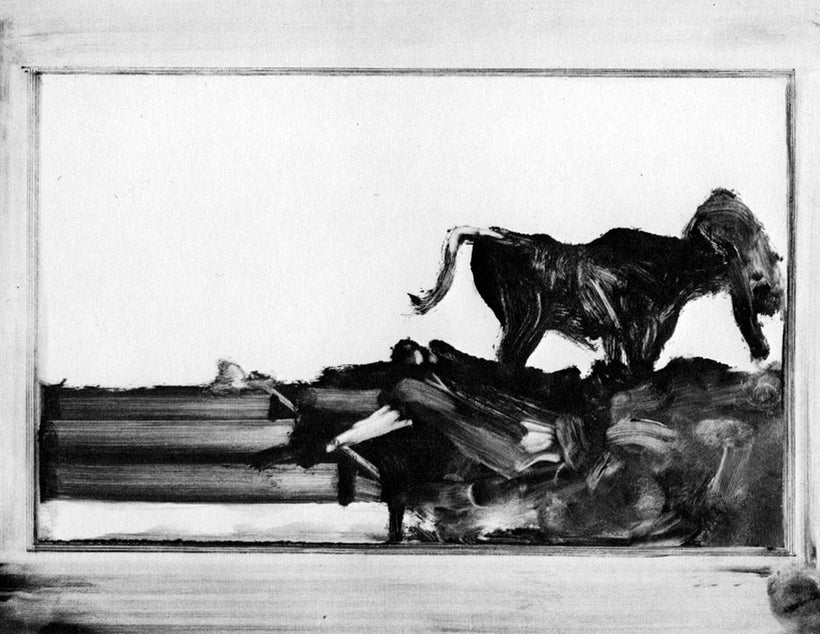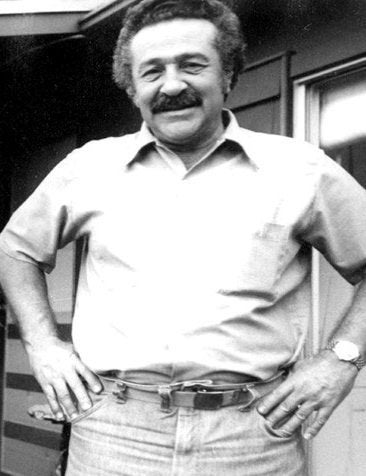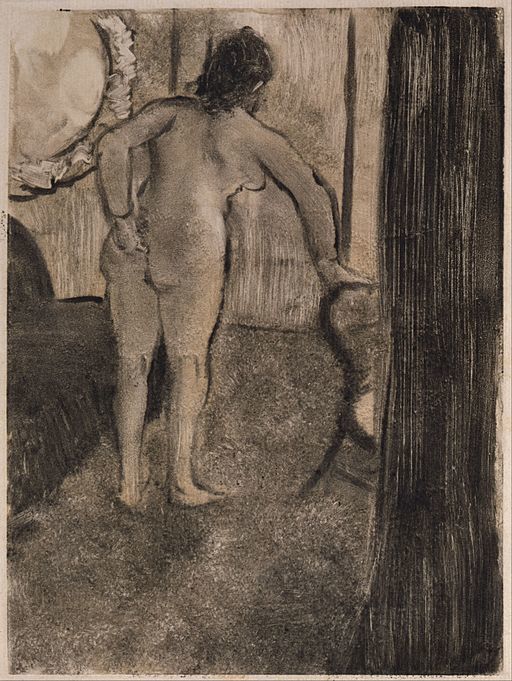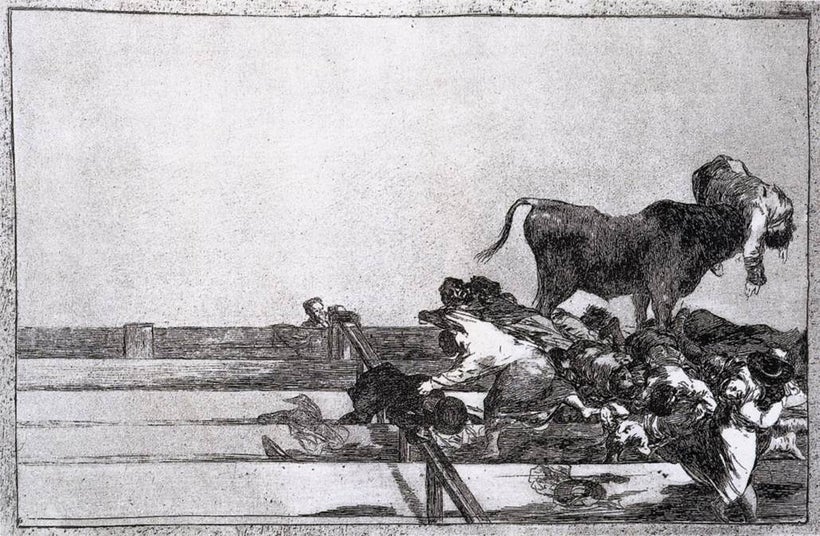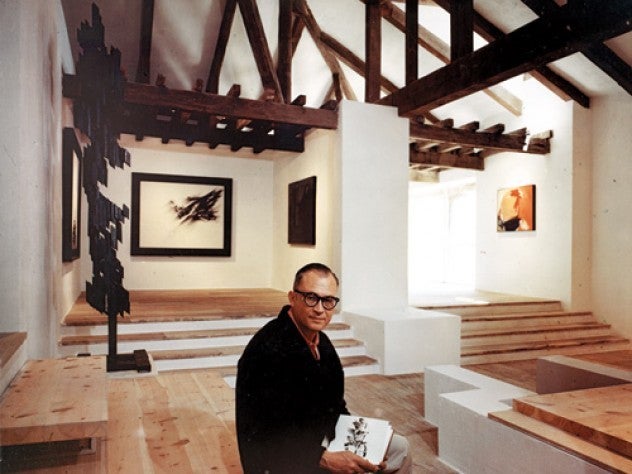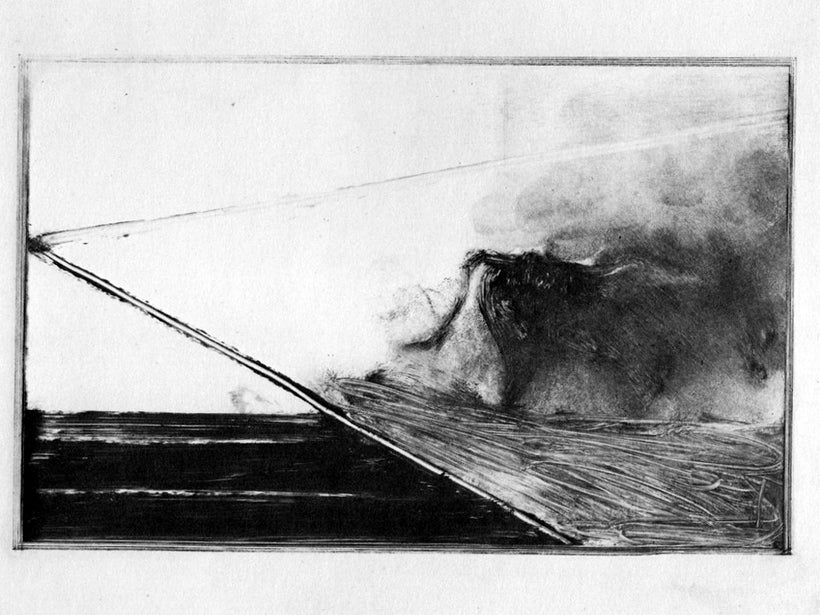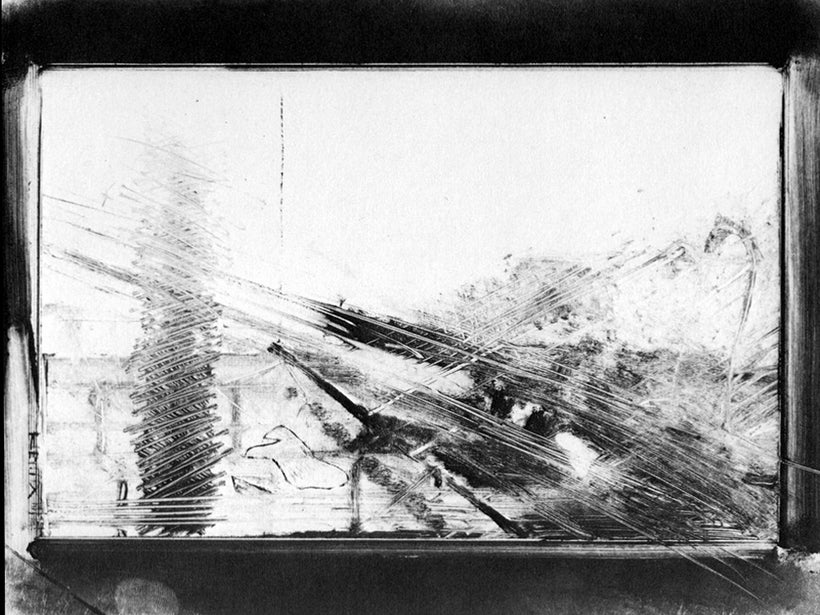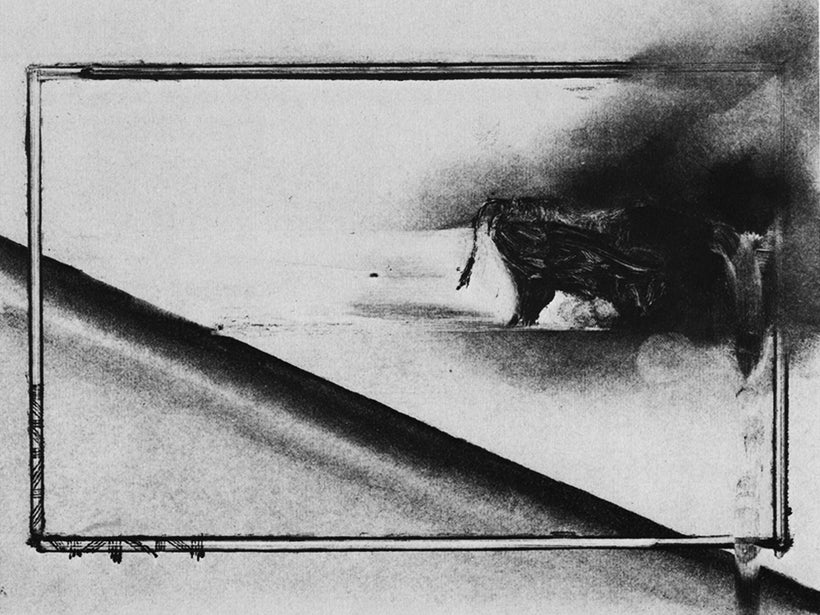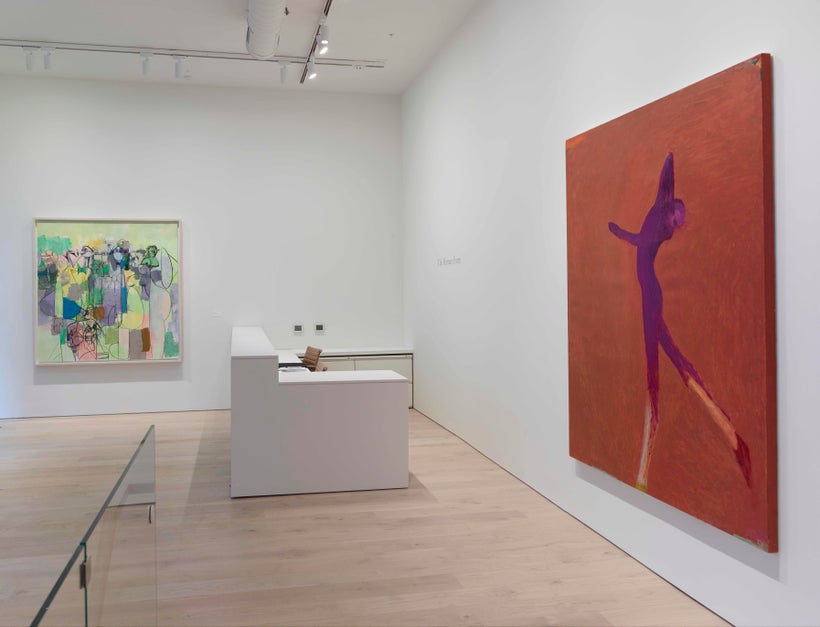©THE ESTATE OF NATHAN OLIVEIRA
The late Nathan Oliveira (1928-2010)—an artist who was rarely satisfied enough with any single image to call it finished—liked to tell his students a story about how he had once confounded and frustrated a European art collector. It went something like this:
This collector had come all the way from Germany, very intent on buying some work, so I sat him down and had him watch a slide show of more than 50 images of a painting in progress. He watched carefully as I clicked through the slides, and when it was over and the lights were back on, he pulled out his checkbook and said “I’ll buy number 17, number 22 and number 38.” When I then explained that the final image was the finished painting and the only one for sale, he was very surprised and put his checkbook away. “But I don’t want that one,” he complained.
Oliveira’s great strength as an artist—and also his great weakness—was an inclination to see art-making as a journey, not a destination: he showed the collector his works in progress to make that point absolutely clear. Like so many modernists, Oliveira had a mind that was disinclined to aim itself towards a fixed or finite result. He was a lateral thinker who saw every image as a way-station linked to an array of others. Working this way can be very neurotic, as it rarely leads to feeling finished, and Oliveira certainly had plenty of stories about the paintings he ruined over the years after putting a signed canvas back on the easel and saying to himself “I’m just going to tweak this spot over here a little bit...”
I thought of Oliveira when I heard the critic Peter Frank speak a few years ago at the Representational Art Conference, where he told us that “Most of what’s out there is just a rehearsal for the real thing.” It’s a rare and wonderful thing when an artist does hit on “the real thing,” but when you embrace the pure open-ended process of just making things—as Oliveira did—the rehearsals themselves could the thrilling. Attempting a way of making art that emphasizes process over product may not pay off immediately in material terms, but it can open up possibilities that a less risky approach would never allow.
Monotype, a medium that he discovered and mastered in the last half of his career, allowed Oliveira the flexibility he needed. It engendered a fast-moving, improvisational way of working that allowed Oliveira to take on challenging subject matter and dialogue the past masters of art history including Goya and Picasso. When I look at Oliveira’s seminal Tauromaquia 21 series—a set of variations on a single Goya etching—I think of Nathan as an artist/toreador, conjuring, erasing, then resurrecting Goya’s bull with his cloak of black etching ink. It’s a bravura performance.
NATHAN OLIVEIRA
Oliveira was an accomplished printmaker who had made his first lithographs at the California College of Arts and Crafts in 1949. In 1952 he exhibited a two-color lithograph of a bullring—an early nod to Picasso and Goya—that already showed signs of process-orientation in its dueling techniques of drawing and scraping. A mid-fifties lithograph of a bull (above) which clearly responds to Picasso’s famous sequence of bull-themed lithographs, already shows Oliveira’s searching and varied approach to depicting the vitality of his subject. Picasso’s series, in which a single lithographic stone was used to render increasingly abstract images of a bull, was a challenge and inspiration that clearly lingered in Oliveira’s mind for many years.
Above: Picasso’s sequence of Bull lithographs from 1945 (video)
Oliveira mainly supported himself by selling lithographs, often for around $20, until winning a Lewis Comfort Tiffany Foundation grant for lithography which was shortly followed by a Guggenheim Fellowship in printmaking. During a brief period when he was unhappy with his easel paintings, between 1963 and 1966, Oliveira concentrated on lithography. When he arrived to teach full-time at Stanford University in 1964 Oliveira brought his own lithographic press and stones, establishing a printmaking studio behind the Stanford Art Gallery. One of his early students, who made lithographs with Oliveira in a small class setting, says that his lessons and lectures were incredibly detailed and intense: she told me that the lesson Oliveira gave on properly opening and closing tins of lithography ink still comes into her mind when she opens or closes a jar of peanut butter.
EDGAR DEGAS
When art historian Lorenz Eitner helped Stanford’s museum acquire a Degas monotype in 1969, Oliveira found himself fascinated by this “forgotten” medium:
The nature of the monotype—the reversal of image, the reflective nature of paper, the brilliance of paper through veils of ink—had all the qualities of printing that I wanted, technically, and it had one other: it left a remnant or ghost of the idea after the impression was made. I could enter back into that image that was still malleable—that I could still manipulate—and extend that initial concept to a different state...
After being presented with a supply of 200 year old paper by a friend at Fullerton College, Oliveira felt ready to rise to the challenge of an artistic dialog with a print from Goya’s epic series of bullfight etchings: La Tauromaquia. He chose Plate 21, a daring composition in which the gored body of a small town mayor is hoisted triumphantly over a screaming crowd exiting the stalls underneath. Its central symbol—the bull—gave him something strong to grapple with, both in symbolic and formal terms.
GOYA (FRANCISCO DE GOYA Y LUCIENTES)
By conjuring up a match with Goya and his bull, Oliveira was able, among other things, to indulge in a reconnection to his Hispanic heritage, which had been awakened by travel and friendship. Oliveira, who was of Portuguese descent, had traveled to Madrid in 1963 to receive a prize and was befriended by Fernando Zóbel de Ayala y Montojo. Zóbel, a Harvard-educated artist and the scion of a wealthy Philippine/Spanish family had recently moved to Spain where he was at the center of a circle of modern artists including Manolo Millares, Antoni Tàpies and others. An avid collector, Zóbel later founded the Museo de Arte Abstracto Español in Cuenca.
COURTESY OF THE AYALA MUSEUM, MANILA
Oliveira and Zóbel exchanged works and when Oliveira first met dealer Paula Kirkeby, who later would show his Tauromaquia 21 series in her gallery, he brought her a work by Zóbel to frame. It’s interesting to note that Zóbel later painted semi-abstract Dialogos (Dialogues) that were variations on paintings by Degas and others.
NATHAN OLIVEIRA
A sense of friendly competition—with living artists and artists of the past—was always an undercurrent in Oliveira’s work, and although the Tauromaquia 21 series is overtly a contest with Goya’s bulls, there is another rivalry going on as well: with Richard Diebenkorn. Around the time that he made the Tauromaquia, Diebenkorn’s abstract Ocean Park paintings were becoming much sought-after and much talked about. Oliveira, who worked with local collectors Hunk and Moo Anderson as they built the collection, was asked in 1974 to help them choose an Ocean Park painting from a New York exhibition: he advised them on the purchase Ocean Park #60 (1973) which is on view today at the Anderson Collection at Stanford University.
Clearly, Diebenkorn’s interest in using geometry as a a kind of scaffolding that sustains abstraction, was something that Oliveira was quoting in his monotypes. Oliveira often said that when he made abstract art it “had to be about something” and Goya’s composition and subject gave him a “something” that to which he could apply both his own ideas and the ideas of his peers. To put it another way, Goya gave him substance and Diebenkorn gave him structure. Two years after Oliveira completed the Tauromaquia 21 series, Diebenkorn visited Stanford and made his own series of monotypes, taking his old friend’s medium for a spin.
NATHAN OLIVEIRA
Oliveira’s monotypes have incredible tonal vitality, and in his Tauromaquia 21 plates one can see how wiping could create sheathes of light. Using his fingertips, dry brushes and the ends of brushes, Oliveira indulged in the subtractive potential of the medium. In Plate #1 from his June 17th session, Goya’s bull emerges from a shaft of light defined by subtractive wiping. In a kind of symbolic triumph the animal’s head and horns are wiped into abstraction in a gesture of Oedipal drama. Hints of Goya’s bullring stalls glimmer below, wiped from the dense ink with a few strokes.
NATHAN OLIVEIRA
Some of the monotypes seem to veer into a kind of destructive chaos. In plate #2 from June 21st, a flurry of wiping has removed the bull entirely, leaving an admirable welter of ghostly forces that have the poetic resonance similar to that found in the works of Cy Twombly. In images like this one, you can feel Oliveira’s willingness to get rid of things to possibly find others. His way of working brings to mind Picasso’s answer to the question “What do you do when you get stuck while making a painting:” Picasso’s reply: “Get rid of the best part.”
NATHAN OLIVEIRA
Working over a period of roughly two months, creating as few as one and as many as eight images in each session, the Tauromaquia 21 series was an exercise in freedom that helped Oliveira invent imagery that would inform and sustain his art-making—paintings, prints and sculptures—for the rest of his career. When Goya’s bull reappears in the final monotype of the series, Plate #5 of June 27th, it seems both controlled and contained, as if Oliveira had made the image his own. With it’s hovering frame—marked by tiny hatchmarks—and its bold diagonal, it is the work of a master: an artist/toreador has risen to the challenge of addressing his masters in his own terms. It’s a sublimation of masculine competition and violence, something that art and culture can offer all of us if we choose.
Nathan Oliveira: Current Exhibitions
January 14, 2017 to April 2, 2017
Sonoma Valley Museum of Art
551 Broadway, Sonoma CA 95476
NATHAN OLIVEIRA
Dates: January 13 - March 4, 2017
Berggruen Gallery
10 Hawthorne Street
San Francisco, CA 94105

